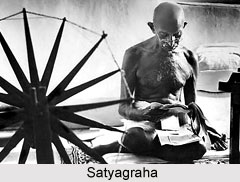 Origin of Satyagraha mainly dates back to 1906 in the country of South Africa, and meaning of Satyagraha can loosely be said as "insistence on truth"- Satya (truth); Agraha (insistence) "soul force" or "truth force". Satyagraha as a term originated in a competition in the news-sheet Indian Opinion in South Africa in the year 1906. It was an adaptation by Mahatma Gandhi as one of the entries in that competition.
Origin of Satyagraha mainly dates back to 1906 in the country of South Africa, and meaning of Satyagraha can loosely be said as "insistence on truth"- Satya (truth); Agraha (insistence) "soul force" or "truth force". Satyagraha as a term originated in a competition in the news-sheet Indian Opinion in South Africa in the year 1906. It was an adaptation by Mahatma Gandhi as one of the entries in that competition.
For a person like Mahatma Gandhi, the term Satyagraha is taken from Sanskrit Language and goes far beyond mere "passive resistance" and became strength in practising non-violent means. According to Gandhi, the term Satyagraha means Truth (Satya) implies love and firmness (Agraha) engenders and therefore serves as a synonym for force. He called the freedom struggle of India Satyagraha as the Force which is born of Truth and Love or non-violence, and gave up the use of the phrase "passive resistance", in connection with it, so much so that even in English writing we often avoided it and used instead the word "Satyagraha" itself or some other equivalent English phrase.
Contrast to Non-Violent Resistance
Mahatma Gandhi differentiated between Non-violence and Satyagraha in many of his public meetings and interactions. Gandhi drew a clear distinction between passive resistance followed in the West and Satyagraha. He said that the doctrine of Satyagraha developed, the expression "passive resistance" ceases even to be synonymous, as passive resistance has admitted of violence as in the case of suffragettes and has been universally acknowledged to be a weapon of the weak. Moreover, passive resistance does not necessarily involve complete adherence to truth under every circumstance. Therefore it is different from Satyagraha in three essentials: Satyagraha is a weapon of the strong; it admits of no violence under any circumstance whatsoever; and it ever insists upon truth.
This article is a stub. You can enrich by adding more information to it. Send your Write Up to content@indianetzone.com



















